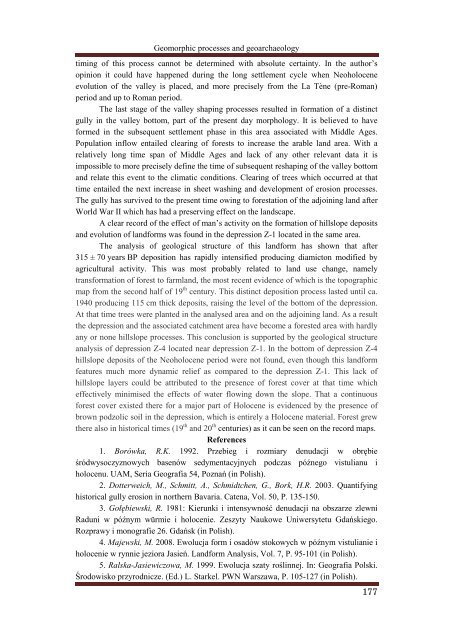extended abstracts - Geomorphic Processes and Geoarchaeology
extended abstracts - Geomorphic Processes and Geoarchaeology
extended abstracts - Geomorphic Processes and Geoarchaeology
You also want an ePaper? Increase the reach of your titles
YUMPU automatically turns print PDFs into web optimized ePapers that Google loves.
<strong>Geomorphic</strong> processes <strong>and</strong> geoarchaeology<br />
timing of this process cannot be determined with absolute certainty. In the author’s<br />
opinion it could have happened during the long settlement cycle when Neoholocene<br />
evolution of the valley is placed, <strong>and</strong> more precisely from the La Tène (pre-Roman)<br />
period <strong>and</strong> up to Roman period.<br />
The last stage of the valley shaping processes resulted in formation of a distinct<br />
gully in the valley bottom, part of the present day morphology. It is believed to have<br />
formed in the subsequent settlement phase in this area associated with Middle Ages.<br />
Population inflow entailed clearing of forests to increase the arable l<strong>and</strong> area. With a<br />
relatively long time span of Middle Ages <strong>and</strong> lack of any other relevant data it is<br />
impossible to more precisely define the time of subsequent reshaping of the valley bottom<br />
<strong>and</strong> relate this event to the climatic conditions. Clearing of trees which occurred at that<br />
time entailed the next increase in sheet washing <strong>and</strong> development of erosion processes.<br />
The gully has survived to the present time owing to forestation of the adjoining l<strong>and</strong> after<br />
World War II which has had a preserving effect on the l<strong>and</strong>scape.<br />
A clear record of the effect of man’s activity on the formation of hillslope deposits<br />
<strong>and</strong> evolution of l<strong>and</strong>forms was found in the depression Z-1 located in the same area.<br />
The analysis of geological structure of this l<strong>and</strong>form has shown that after<br />
315 ± 70 years BP deposition has rapidly intensified producing diamicton modified by<br />
agricultural activity. This was most probably related to l<strong>and</strong> use change, namely<br />
transformation of forest to farml<strong>and</strong>, the most recent evidence of which is the topographic<br />
map from the second half of 19 th century. This distinct deposition process lasted until ca.<br />
1940 producing 115 cm thick deposits, raising the level of the bottom of the depression.<br />
At that time trees were planted in the analysed area <strong>and</strong> on the adjoining l<strong>and</strong>. As a result<br />
the depression <strong>and</strong> the associated catchment area have become a forested area with hardly<br />
any or none hillslope processes. This conclusion is supported by the geological structure<br />
analysis of depression Z-4 located near depression Z-1. In the bottom of depression Z-4<br />
hillslope deposits of the Neoholocene period were not found, even though this l<strong>and</strong>form<br />
features much more dynamic relief as compared to the depression Z-1. This lack of<br />
hillslope layers could be attributed to the presence of forest cover at that time which<br />
effectively minimised the effects of water flowing down the slope. That a continuous<br />
forest cover existed there for a major part of Holocene is evidenced by the presence of<br />
brown podzolic soil in the depression, which is entirely a Holocene material. Forest grew<br />
there also in historical times (19 th <strong>and</strong> 20 th centuries) as it can be seen on the record maps.<br />
References<br />
1. Borówka, R.K. 1992. Przebieg i rozmiary denudacji w obrębie<br />
śródwysoczyznowych basenów sedymentacyjnych podczas późnego vistulianu i<br />
holocenu. UAM, Seria Geografia 54, Poznań (in Polish).<br />
2. Dotterweich, M., Schmitt, A., Schmidtchen, G., Bork, H.R. 2003. Quantifying<br />
historical gully erosion in northern Bavaria. Catena, Vol. 50, P. 135-150.<br />
3. Gołębiewski, R. 1981: Kierunki i intensywność denudacji na obszarze zlewni<br />
Raduni w późnym würmie i holocenie. Zeszyty Naukowe Uniwersytetu Gdańskiego.<br />
Rozprawy i monografie 26. Gdańsk (in Polish).<br />
4. Majewski, M. 2008. Ewolucja form i osadów stokowych w późnym vistulianie i<br />
holocenie w rynnie jeziora Jasień. L<strong>and</strong>form Analysis, Vol. 7, P. 95-101 (in Polish).<br />
5. Ralska-Jasiewiczowa, M. 1999. Ewolucja szaty roślinnej. In: Geografia Polski.<br />
Środowisko przyrodnicze. (Ed.) L. Starkel. PWN Warszawa, P. 105-127 (in Polish).<br />
177


